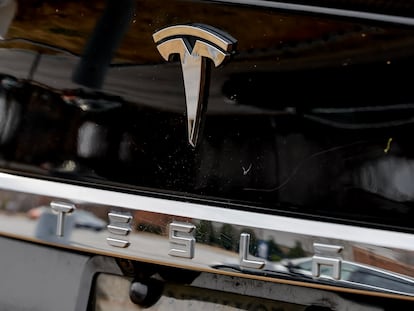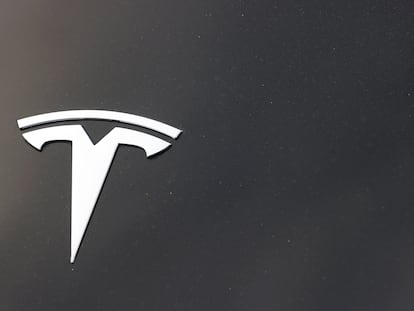Tesla to review 362,000 vehicles due to safety concerns about its ‘Full Self-Driving’ system in the US
The federal highway safety agency believes that a software glitch, which will be updated, has led to several accidents at intersections and traffic lights

A new setback for Elon Musk. US safety regulators have pressured Tesla into recalling 362,000 vehicles with its “Full Self-Driving” system, which has been available since 2015 and costs $15,000 to activate, because it could provoke accidents as it misbehaves around intersections and doesn’t always follow speed limits. The review, part of a larger investigation by the National Highway Traffic Safety Administration (NHTSA) into Tesla’s automated driving systems, is the most serious action taken yet against the electric vehicle maker. The news triggered an immediate drop in the company’s share price on the Nasdaq index, with a mid-session loss of 3.35% and closing at down 5.7%.
The safety agency says in documents posted on its website Thursday that Tesla will fix the concerns with an online software update in the coming weeks. However, it also says that the company doesn’t agree with the agency’s concerns as it is not aware of any crashes, resulting in injury or death.
The situation raises questions about CEO Elon Musk’s claims that he can prove to regulators that cars equipped with “Full Self-Driving” are safer than humans, and that humans almost never have to touch the controls. Musk at one point had promised that a fleet of autonomous robotaxis would be in use in 2020. The latest news appears to push that development further into the future.
The review affects Model S, Model X, Model 3 and Model Y, all of which were manufactured between 2016 and 2023 and are equipped with one of the two autopilot software systems, the so-called FSD Beta. “The feature could potentially infringe upon local traffic laws or customs while executing certain driving maneuvers,” NHTSA stated.
Among possible examples of problems with the system, which is being tested on public roads by as many as 400,000 Tesla owners, the agency cites traveling straight through an intersection while in a turn-only lane, failing to come to a complete stop at stop signs, or going through an intersection during a yellow traffic light without proper caution. In addition, the system may not adequately respond to changes in posted speed limits, or it may not account for the driver’s adjustments in speed, the documents said.
However, NHTSA also said in its statement that it found the issues during tests performed as part of an investigation into Tesla’s “Full Self-Driving” and “Autopilot” software, and that the investigation remains open because the review doesn’t address the full scope of everything NHTSA is scrutinizing.
The federal agency’s announcement comes just hours after the White House, which promotes the manufacturing and use of electric vehicles as part of its plan to tackle climate change, revealed that Musk’s company will be opening part of its network of charging stations to its competitors. The Democratic administration aims to have at least 500,000 publicly accessible electric vehicle chargers on U.S. roads by 2030, regardless of the brand of vehicle they drive.
As for the safety of Tesla vehicles, manned or unmanned, there is a succession of accident reports worldwide. An out-of-control Tesla killed two people in Guangdong province (China) last November, although there is no evidence that the driver, who tested negative for alcohol and drugs, had activated the Autopilot system. And earlier this month, it emerged that a Tesla that caused a crash in San Francisco in November did have AutoPilot activated. The crash, which involved eight vehicles, injured several people, including a child. NHTSA has been investigating Tesla’s automated systems since June of 2016 when a driver using Autopilot was killed after his Tesla went under a tractor-trailer crossing its path in Florida. Now, the agency has sent investigators to 35 Tesla crashes in which automated systems are suspected of being used. Nineteen people have died in those crashes, including two motorcyclists.
Cars manufactured by Tesla have two different automated driving systems, Autopilot, intended for use on highways and expressways, and the FSB Beta, for urban environments and supposedly capable of recognizing traffic lights, stop signs and making turns in the city. The Beta is the one that has allegedly caused the failures in the vehicles to be reviewed. In the case of both Guangdong and San Francisco, the origin of the incident was in what is known as phantom braking, or automatic braking, when the Autopilot and FSD systems activate the brake forcefully for no apparent reason, with dire consequences. The road safety agency has pointed out, as Tesla itself also says in its website, that despite Autopilot programs, the driving of the vehicle always requires human supervision.
Since January of 2022, Tesla has issued 20 recalls, including several that were required by NHTSA. The recalls include one from January of last year for “Full Self-Driving” vehicles being programmed to run stop signs at slow speeds. Others included seat belt chimes that may not sound when vehicles are started and drivers haven’t buckled up, heat pumps that don’t defrost windshields quickly enough, and cars that make sounds that obscure pedestrian warnings.
In addition to a lawsuit against Musk for his tweets about the future of the company, Tesla has experienced one of the worst stock market performances in memory on Wall Street in recent months. The South African tycoon’s company strung together the worst stock market streak since 2018 last year and at the end of December had lost almost 70% of its value. In addition to his raucous takeover of Twitter, concerns about a cooling of demand and the government’s promotion of electric cars, with direct subsidies to individuals, have weighed down the electric car pioneer and pushed it to offer attractive discounts on its cars.
Sign up for our weekly newsletter to get more English-language news coverage from EL PAÍS USA Edition
Tu suscripción se está usando en otro dispositivo
¿Quieres añadir otro usuario a tu suscripción?
Si continúas leyendo en este dispositivo, no se podrá leer en el otro.
FlechaTu suscripción se está usando en otro dispositivo y solo puedes acceder a EL PAÍS desde un dispositivo a la vez.
Si quieres compartir tu cuenta, cambia tu suscripción a la modalidad Premium, así podrás añadir otro usuario. Cada uno accederá con su propia cuenta de email, lo que os permitirá personalizar vuestra experiencia en EL PAÍS.
¿Tienes una suscripción de empresa? Accede aquí para contratar más cuentas.
En el caso de no saber quién está usando tu cuenta, te recomendamos cambiar tu contraseña aquí.
Si decides continuar compartiendo tu cuenta, este mensaje se mostrará en tu dispositivo y en el de la otra persona que está usando tu cuenta de forma indefinida, afectando a tu experiencia de lectura. Puedes consultar aquí los términos y condiciones de la suscripción digital.
More information
Archived In
Últimas noticias
Most viewed
- Reinhard Genzel, Nobel laureate in physics: ‘One-minute videos will never give you the truth’
- Oona Chaplin: ‘I told James Cameron that I was living in a treehouse and starting a permaculture project with a friend’
- Pablo Escobar’s hippos: A serious environmental problem, 40 years on
- Chevy Chase, the beloved comedian who was a monster off camera: ‘Not everyone hated him, just the people who’ve worked with him’
- Why we lost the habit of sleeping in two segments and how that changed our sense of time










































